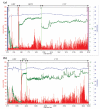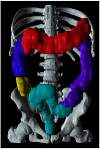Assessment of Gastrointestinal Autonomic Dysfunction: Present and Future Perspectives
- PMID: 33807256
- PMCID: PMC8037288
- DOI: 10.3390/jcm10071392
Assessment of Gastrointestinal Autonomic Dysfunction: Present and Future Perspectives
Abstract
The autonomic nervous system delicately regulates the function of several target organs, including the gastrointestinal tract. Thus, nerve lesions or other nerve pathologies may cause autonomic dysfunction (AD). Some of the most common causes of AD are diabetes mellitus and α-synucleinopathies such as Parkinson's disease. Widespread dysmotility throughout the gastrointestinal tract is a common finding in AD, but no commercially available method exists for direct verification of enteric dysfunction. Thus, assessing segmental enteric physiological function is recommended to aid diagnostics and guide treatment. Several established assessment methods exist, but disadvantages such as lack of standardization, exposure to radiation, advanced data interpretation, or high cost, limit their utility. Emerging methods, including high-resolution colonic manometry, 3D-transit, advanced imaging methods, analysis of gut biopsies, and microbiota, may all assist in the evaluation of gastroenteropathy related to AD. This review provides an overview of established and emerging assessment methods of physiological function within the gut and assessment methods of autonomic neuropathy outside the gut, especially in regards to clinical performance, strengths, and limitations for each method.
Keywords: Parkinson’s disease; autonomic dysfunction; breath test; diabetes mellitus; gastrointestinal; imaging; investigations; manometry; motility.
Conflict of interest statement
The authors declare no conflict of interest. The funders had no role in the writing of the manuscript or in the decision to publish the results.
Figures






Similar articles
-
Diabetic autonomic neuropathy.Diabetes Care. 2003 May;26(5):1553-79. doi: 10.2337/diacare.26.5.1553. Diabetes Care. 2003. PMID: 12716821 Review.
-
Slow-transit constipation: solitary symptom of a systemic gastrointestinal disease.Dis Colon Rectum. 1999 Feb;42(2):231-40. doi: 10.1007/BF02237134. Dis Colon Rectum. 1999. PMID: 10211501
-
Quantitative gastrointestinal function and corresponding symptom profiles in autonomic neuropathy.Front Neurol. 2022 Dec 15;13:1027348. doi: 10.3389/fneur.2022.1027348. eCollection 2022. Front Neurol. 2022. PMID: 36588909 Free PMC article.
-
Established and emerging methods for assessment of small and large intestinal motility.Neurogastroenterol Motil. 2017 Jul;29(7). doi: 10.1111/nmo.13008. Epub 2017 Jan 13. Neurogastroenterol Motil. 2017. PMID: 28086261 Review.
-
Assessment of the cardiovascular and gastrointestinal autonomic complications of diabetes.World J Diabetes. 2016 Aug 25;7(16):321-32. doi: 10.4239/wjd.v7.i16.321. World J Diabetes. 2016. PMID: 27625746 Free PMC article. Review.
Cited by
-
Effectiveness of Novel Sympathetic Nerve Entrapment Point Injections for Chronic Migraine: A Pilot Study.Life (Basel). 2023 Dec 28;14(1):57. doi: 10.3390/life14010057. Life (Basel). 2023. PMID: 38255672 Free PMC article.
-
Pathways to Anxiety and Depression in Autistic Adolescents and Adults.Depress Anxiety. 2023 Oct 3;2023:5575932. doi: 10.1155/2023/5575932. eCollection 2023. Depress Anxiety. 2023. PMID: 40224589 Free PMC article.
-
SmartPill™ Administration to Assess Gastrointestinal Function after Spinal Cord Injury in a Porcine Model-A Preliminary Study.Biomedicines. 2023 Jun 7;11(6):1660. doi: 10.3390/biomedicines11061660. Biomedicines. 2023. PMID: 37371755 Free PMC article.
-
Nondiabetic Gastroparesis Among Multiple Sclerosis Patients: A Retrospective Analysis of Patient Characteristics From the United States.Health Sci Rep. 2025 Mar 5;8(3):e70538. doi: 10.1002/hsr2.70538. eCollection 2025 Mar. Health Sci Rep. 2025. PMID: 40051491 Free PMC article. No abstract available.
-
Enteric neuropathy in diabetes: Implications for gastrointestinal function.World J Gastroenterol. 2024 Jun 14;30(22):2852-2865. doi: 10.3748/wjg.v30.i22.2852. World J Gastroenterol. 2024. PMID: 38947292 Free PMC article. Review.
References
-
- Mathias C.J.B.R. Autonomic Failure. A Textbook of Clinical Disorders of the Autonomic Nervous System. 5th ed. University Press; Oxford, UK: 2013.
Publication types
Grants and funding
LinkOut - more resources
Full Text Sources
Other Literature Sources

